Vegetation Dynamics and Its Trends Associated with Extreme Climate Events in the Yellow River Basin, China
Abstract
:1. Introduction
2. Materials and Methods
2.1. Study Area
2.2. Materials
2.2.1. Carbon Flux Data
2.2.2. Vegetation Indicator Dataset
2.2.3. Land Use and Land Cover (LULC) Data
2.2.4. Meteorological Observation Data
2.3. Methodology
2.3.1. Tendency Analysis
2.3.2. Association Analysis Method
3. Results
3.1. Vegetation Growth Status
3.1.1. Land Use and Land Cover Change
3.1.2. Spatio–Temporal Patterns of NPP and NDVI
3.2. Spatio–Temporal Patterns of Climate Extremes Indexes
3.3. Relationship between NPP, NDVI, and Climate Extreme Indexes
3.3.1. Relationship between NPP, NDVI, and Climate Extreme Indexes in the Yellow River Basin
3.3.2. Relationship between NPP, NDVI, and Climate Extreme Indexes in Vegetation Ecosystem
4. Discussion
4.1. Vegetation Growth
4.2. Extreme Temperature and Precipitation
4.3. Vegetation Growth Responses to Extreme Climate
4.4. Limitations and Prospects
5. Conclusions
Author Contributions
Funding
Data Availability Statement
Conflicts of Interest
References
- Zhao, L.; Dai, A.; Dong, B. Changes in global vegetation activity and its driving factors during 1982–2013. Agric. For. Meteorol. 2018, 249, 198–209. [Google Scholar] [CrossRef]
- Zhang, Z.; Xin, Q.; Li, W. Machine Learning-Based Modeling of Vegetation Leaf Area Index and Gross Primary Productivity across North America and Comparison with a Process-Based Model. J. Adv. Model. Earth Syst. 2021, 13, e2021MS002802. [Google Scholar] [CrossRef]
- Jiang, W.; Yuan, L.; Wang, W.; Cao, R.; Zhang, Y.; Shen, W. Spatio-temporal analysis of vegetation variation in the Yellow River Basin. Ecol. Indic. 2015, 51, 117–126. [Google Scholar] [CrossRef]
- Yao, R.; Cao, J.; Wang, L.; Zhang, W.; Wu, X. Urbanization effects on vegetation cover in major African cities during 2001–2017. Int. J. Appl. Earth Obs. Geoinf. 2019, 75, 44–53. [Google Scholar] [CrossRef]
- IPCC. Climate Change 2021: The Physical Science Basis. Contribution of Working Group I to the Sixth Assessment Report of the Intergovernmental Panel on Climate Change; Cambridge University Press: Cambridge, UK, 2021. [Google Scholar]
- Alexander, L.V.; Zhang, X.; Peterson, T.C.; Caesar, J.; Gleason, B.; Klein Tank, A.M.G.; Haylock, M.; Collins, D.; Trewin, B.; Rahimzadeh, F.; et al. Global observed changes in daily climate extremes of temperature and precipitation. J. Geophys. Res. Atmos. 2006, 111, D05109. [Google Scholar] [CrossRef]
- Li, J.; Su, Z.; Jiang, J.; Chen, W.; Yu, N.; Li, X.; Xie, J.; Wei, J. Spatial-Temporal Change in Vegetation Cover and Climate Factor Drivers of Variation in the Haihe River Basin 2003-2016. IOP Conf. Ser. Earth Environ. Sci. 2021, 697, 012005. [Google Scholar] [CrossRef]
- Li, C.; Wang, R. Recent changes of precipitation in Gansu, Northwest China: An index-based analysis. Theor. Appl. Climatol. 2017, 129, 397–412. [Google Scholar] [CrossRef]
- Shi, G.; Ye, P. Assessment on Temporal and Spatial Variation Analysis of Extreme Temperature Indices: A Case Study of the Yangtze River Basin. Int. J. Environ. Res. Public Health 2021, 18, 10936. [Google Scholar] [CrossRef]
- Li, X.; Zhang, K.; Gu, P.; Feng, H.; Yin, Y.; Chen, W.; Cheng, B. Changes in precipitation extremes in the Yangtze River Basin during 1960–2019 and the association with global warming, ENSO, and local effects. Sci. Total Environ. 2021, 760, 144244. [Google Scholar] [CrossRef]
- Cui, L.; Wang, L.; Qu, S.; Singh, R.P.; Lai, Z.; Yao, R. Spatiotemporal extremes of temperature and precipitation during 1960–2015 in the Yangtze River Basin (China) and impacts on vegetation dynamics. Theor. Appl. Climatol. 2019, 136, 675–692. [Google Scholar] [CrossRef]
- Saleem, A.; Awange, J.L.; Kuhn, M.; John, B.; Hu, K. Impacts of extreme climate on Australia’s green cover (2003–2018): A MODIS and mascon probe. Sci. Total Environ. 2021, 766, 142567. [Google Scholar] [CrossRef] [PubMed]
- Xu, X.; Jiang, H.; Guan, M.; Wang, L.; Huang, Y.; Jiang, Y.; Wang, A. Vegetation responses to extreme climatic indices in coastal China from 1986 to 2015. Sci. Total Environ. 2020, 744, 140784. [Google Scholar] [CrossRef] [PubMed]
- Vogel, E.; Donat, M.G.; Alexander, L.V.; Meinshausen, M.; Ray, D.K.; Karoly, D.; Meinshausen, N.; Frieler, K. The effects of climate extremes on global agricultural yields. Environ. Res. Lett. 2019, 14, 054010. [Google Scholar] [CrossRef]
- Deng, H.; Yin, Y.; Han, X. Vulnerability of vegetation activities to drought in Central Asia. Environ. Res. Lett. 2020, 15, 084005. [Google Scholar] [CrossRef]
- Liu, G.; Liu, H.; Yin, Y. Global patterns of NDVI-indicated vegetation extremes and their sensitivity to climate extremes. Environ. Res. Lett. 2013, 8, 025009. [Google Scholar] [CrossRef]
- Piao, S.; Tan, J.; Chen, A.; Fu, Y.H.; Ciais, P.; Liu, Q.; Janssens, I.A.; Vicca, S.; Zeng, Z.; Jeong, S.-J.; et al. Leaf onset in the northern hemisphere triggered by daytime temperature. Nat. Commun. 2015, 6, 6911. [Google Scholar] [CrossRef] [PubMed]
- Zhang, Z.; Lu, L.; Zhao, Y.; Wang, Y.; Wei, D.; Wu, X.; Ma, X. Recent advances in using Chinese Earth observation satellites for remote sensing of vegetation. ISPRS J. Photogramm. Remote Sens. 2023, 195, 393–407. [Google Scholar] [CrossRef]
- Orusa, T.; Viani, A.; Moyo, B.; Cammareri, D.; Borgogno-Mondino, E. Risk Assessment of Rising Temperatures Using Landsat 4-9 LST Time Series and Meta® Population Dataset: An Application in Aosta Valley, NW Italy. Remote Sens. 2023, 15, 2348. [Google Scholar] [CrossRef]
- Seto, K.C.; Shepherd, J.M. Global urban land-use trends and climate impacts. Curr. Opin. Environ. Sustain. 2009, 1, 89–95. [Google Scholar] [CrossRef]
- Zhang, Y.; Hong, S.; Liu, D.; Piao, S. Susceptibility of vegetation low-growth to climate extremes on Tibetan Plateau. Agric. For. Meteorol. 2023, 331, 109323. [Google Scholar] [CrossRef]
- Mo, Y.; Zhang, X.; Liu, Z.; Zhang, J.; Hao, F.; Fu, Y. Effects of Climate Extremes on Spring Phenology of Temperate Vegetation in China. Remote Sens. 2023, 15, 686. [Google Scholar] [CrossRef]
- He, L.; Guo, J.; Yang, W.; Jiang, Q.; Chen, L.; Tang, K. Multifaceted responses of vegetation to average and extreme climate change over global drylands. Sci. Total Environ. 2023, 858, 159942. [Google Scholar] [CrossRef]
- Wei, Y.; Yu, M.; Wei, J.; Zhou, B. Impacts of Extreme Climates on Vegetation at Middle-to-High Latitudes in Asia. Remote Sens. 2023, 15, 1251. [Google Scholar] [CrossRef]
- Yan, W.; He, Y.; Cai, Y.; Qu, X.; Cui, X. Relationship between extreme climate indices and spatiotemporal changes of vegetation on Yunnan Plateau from 1982 to 2019. Glob. Ecol. Conserv. 2021, 31, e01813. [Google Scholar] [CrossRef]
- Niu, C.; Qi, Y.; Guo, A.; Chang, J. Grain yield and food security evaluation in the yellow river basin under climate change and water resources constraints. Front. Water 2022, 4, 908945. [Google Scholar] [CrossRef]
- Zhan, C.; Liang, C.; Zhao, L.; Jiang, S.; Niu, K.; Zhang, Y. Drought-related cumulative and time-lag effects on vegetation dynamics across the Yellow River Basin, China. Ecol. Indic. 2022, 143, 109409. [Google Scholar] [CrossRef]
- Zhu, X.; Lee, S.-Y.; Wen, X.; Ji, Z.; Lin, L.; Wei, Z.; Zheng, Z.; Xu, D.; Dong, W. Extreme climate changes over three major river basins in China as seen in CMIP5 and CMIP6. Clim. Dyn. 2021, 57, 1187–1205. [Google Scholar] [CrossRef]
- Liu, C.; Zhang, X.; Wang, T.; Chen, G.; Zhu, K.; Wang, Q.; Wang, J. Detection of vegetation coverage changes in the Yellow River Basin from 2003 to 2020. Ecol. Indic. 2022, 138, 108818. [Google Scholar] [CrossRef]
- Cao, Y.; Xie, Z.; Woodgate, W.; Ma, X.; Cleverly, J.; Pang, Y.; Qin, F.; Huete, A. Ecohydrological decoupling of water storage and vegetation attributed to China’s large-scale ecological restoration programs. J. Hydrol. 2022, 615, 128651. [Google Scholar] [CrossRef]
- Wang, Y.; Luo, Y.; Shafeeque, M. Interpretation of vegetation phenology changes using daytime and night-time temperatures across the Yellow River Basin, China. Sci. Total Environ. 2019, 693, 133553. [Google Scholar] [CrossRef]
- Liang, K.; Liu, S.; Bai, P.; Nie, R. The Yellow River basin becomes wetter or drier? The case as indicated by mean precipitation and extremes during 1961–2012. Theor. Appl. Climatol. 2015, 119, 701–722. [Google Scholar] [CrossRef]
- Li, Q.; Cao, Y.; Miao, S.; Huang, X. Spatiotemporal Characteristics of Drought and Wet Events and Their Impacts on Agriculture in the Yellow River Basin. Land 2022, 11, 556. [Google Scholar] [CrossRef]
- Rong, T.; Long, L.H. Quantitative Assessment of NPP Changes in the Yellow River Source Area from 2001 to 2017. IOP Conf. Ser. Environ. Earth Sci. 2021, 687, 012002. [Google Scholar] [CrossRef]
- Peng, D.; Wu, C.; Zhang, B.; Huete, A.; Zhang, X.; Sun, R.; Lei, L.; Huang, W.; Liu, L.; Liu, X.; et al. The Influences of Drought and Land-Cover Conversion on Inter-Annual Variation of NPP in the Three-North Shelterbelt Program Zone of China Based on MODIS Data. PLoS ONE 2016, 11, e0158173. [Google Scholar] [CrossRef] [PubMed]
- Cui, T.; Wang, Y.; Sun, R.; Qiao, C.; Fan, W.; Jiang, G.; Hao, L.; Zhang, L. Estimating vegetation primary production in the Heihe River Basin of China with multi-source and multi-scale data. PLoS ONE 2016, 11, e0153971. [Google Scholar] [CrossRef] [PubMed]
- Yu, T.; Sun, R.; Xiao, Z.; Zhang, Q.; Liu, G.; Cui, T.; Wang, J. Estimation of global vegetation productivity from global land surface satellite data. Remote Sens. 2018, 10, 327. [Google Scholar] [CrossRef]
- Wang, M.; Sun, R.; Zhu, A.; Xiao, Z. Evaluation and comparison of light use efficiency and gross primary productivity using three different approaches. Remote Sens. 2020, 12, 1003. [Google Scholar] [CrossRef]
- Luo, M.; Sa, C.; Meng, F.; Duan, Y.; Liu, T.; Bao, Y. Assessing extreme climatic changes on a monthly scale and their implications for vegetation in Central Asia. J. Clean. Prod. 2020, 271, 122396. [Google Scholar] [CrossRef]
- Wu, D.; Wu, H.; Zhao, X.; Zhou, T.; Tang, B.; Zhao, W.; Jia, K. Evaluation of Spatiotemporal Variations of Global Fractional Vegetation Cover Based on GIMMS NDVI Data from 1982 to 2011. Remote Sens. 2014, 6, 4217–4239. [Google Scholar] [CrossRef]
- Liu, H.; Gong, P.; Wang, J.; Clinton, N.; Bai, Y.; Liang, S. Annual dynamics of global land cover and its long-term changes from 1982 to 2015. Earth Syst. Sci. Data 2020, 12, 1217–1243. [Google Scholar] [CrossRef]
- Ren, Y.; Zhang, F.; Zhao, C.; Wang, D.; Li, J.; Zhang, J.; Cheng, Z. Spatiotemporal changes of extreme climate indices and their influence and response factors in a typical cold river basin in Northeast China. Theor. Appl. Climatol. 2023, 152, 1285–1309. [Google Scholar] [CrossRef]
- Yang, Y.; Wang, S.; Bai, X.; Tan, Q.; Li, Q.; Wu, L.; Tian, S.; Hu, Z.; Li, C.; Deng, Y. Factors Affecting Long-Term Trends in Global NDVI. Forests 2019, 10, 372. [Google Scholar] [CrossRef]
- Zhang, F.; Zhang, Z.; Kong, R.; Chang, J.; Tian, J.; Zhu, B.; Jiang, S.; Chen, X.; Xu, C.-Y. Changes in Forest Net Primary Productivity in the Yangtze River Basin and Its Relationship with Climate Change and Human Activities. Remote Sens. 2019, 11, 1451. [Google Scholar] [CrossRef]
- Liu, Z.; Wang, H.; Li, N.; Zhu, J.; Pan, Z.; Qin, F. Spatial and Temporal Characteristics and Driving Forces of Vegetation Changes in the Huaihe River Basin from 2003 to 2018. Sustainability 2020, 12, 2198. [Google Scholar] [CrossRef]
- Ndlovu, M.; Clulow, A.D.; Savage, M.J.; Nhamo, L.; Magidi, J.; Mabhaudhi, T. An Assessment of the Impacts of Climate Variability and Change in KwaZulu-Natal Province, South Africa. Atmosphere 2021, 12, 427. [Google Scholar] [CrossRef]
- Sun, X.; Li, G.; Wang, J.; Wang, M. Quantifying the Land Use and Land Cover Changes in the Yellow River Basin while Accounting for Data Errors Based on GlobeLand30 Maps. Land 2021, 10, 31. [Google Scholar] [CrossRef]
- Ji, Q.; Liang, W.; Fu, B.; Zhang, W.; Yan, J.; Lü, Y.; Yue, C.; Jin, Z.; Lan, Z.; Li, S.; et al. Mapping Land Use/Cover Dynamics of the Yellow River Basin from 1986 to 2018 Supported by Google Earth Engine. Remote Sens. 2021, 13, 1299. [Google Scholar] [CrossRef]
- Wang, L.; Zhu, Q.; Zhang, J.; Liu, J.; Zhu, C.; Qu, L. Vegetation dynamics alter the hydrological interconnections between upper and mid-lower reaches of the Yellow River Basin, China. Ecol. Indic. 2023, 148, 110083. [Google Scholar] [CrossRef]
- Zhan, C.; Liang, C.; Zhao, L.; Jiang, S.; Niu, K.; Zhang, Y.; Cheng, L. Vegetation Dynamics and its Response to Climate Change in the Yellow River Basin, China. Front. Environ. Sci. 2022, 10, 892747. [Google Scholar] [CrossRef]
- Lamchin, M.; Wang, S.W.; Lim, C.-H.; Ochir, A.; Pavel, U.; Gebru, B.M.; Choi, Y.; Jeon, S.W.; Lee, W.-K. Understanding global spatio-temporal trends and the relationship between vegetation greenness and climate factors by land cover during 1982–2014. Glob. Ecol. Conserv. 2020, 24, e01299. [Google Scholar] [CrossRef]
- Ukkola, A.M.; De Kauwe, M.G.; Roderick, M.L.; Burrell, A.; Lehmann, P.; Pitman, A.J. Annual precipitation explains variability in dryland vegetation greenness globally but not locally. Glob. Change Biol. 2021, 27, 4367–4380. [Google Scholar] [CrossRef]
- Guo, E.; Zhang, J.; Wang, Y.; Quan, L.; Zhang, R.; Zhang, F.; Zhou, M. Spatiotemporal variations of extreme climate events in Northeast China during 1960–2014. Ecol. Indic. 2019, 96, 669–683. [Google Scholar] [CrossRef]
- Wang, P.; Cheng, Q.; Jin, H. Divergent vegetation variation and the response to extreme climate events in the National Nature Reserves in Southwest China, 1961–2019. Ecol. Indic. 2023, 150, 110247. [Google Scholar] [CrossRef]
- Sa’adi, Z.; Yaseen, Z.M.; Farooque, A.A.; Mohamad, N.A.; Muhammad, M.K.I.; Iqbal, Z. Long-term trend analysis of extreme climate in Sarawak tropical peatland under the influence of climate change. Weather Clim. Extrem. 2023, 40, 100554. [Google Scholar] [CrossRef]
- Madakumbura, G.D.; Thackeray, C.W.; Norris, J.; Goldenson, N.; Hall, A. Anthropogenic influence on extreme precipitation over global land areas seen in multiple observational datasets. Nat. Commun. 2021, 12, 3944. [Google Scholar] [CrossRef]
- Duan, W.; Zou, S.; Christidis, N.; Schaller, N.; Chen, Y.; Sahu, N.; Li, Z.; Fang, G.; Zhou, B. Changes in temporal inequality of precipitation extremes over China due to anthropogenic forcings. npj Clim. Atmos. Sci. 2022, 5, 33. [Google Scholar] [CrossRef]
- Hu, T.; Sun, Y. Anthropogenic influence on extreme temperatures in China based on CMIP6 models. Int. J. Climatol. 2022, 42, 2981–2995. [Google Scholar] [CrossRef]
- Wang, J.; Rich, P.M.; Price, K.P. Temporal responses of NDVI to precipitation and temperature in the central Great Plains, USA. Int. J. Remote Sens. 2003, 24, 2345–2364. [Google Scholar] [CrossRef]
- Zhao, F.; Ma, S.; Wu, Y.; Qiu, L.; Wang, W.; Lian, Y.; Chen, J.; Sivakumar, B. The role of climate change and vegetation greening on evapotranspiration variation in the Yellow River Basin, China. Agric. For. Meteorol. 2022, 316, 108842. [Google Scholar] [CrossRef]
- Higgins, S.I.; Conradi, T.; Muhoko, E. Shifts in vegetation activity of terrestrial ecosystems attributable to climate trends. Nat. Geosci. 2023, 16, 147–153. [Google Scholar] [CrossRef]
- Leake, I. Climate extremes drive negative vegetation growth. Nat. Rev. Earth Environ. 2023, 4, 68. [Google Scholar] [CrossRef]
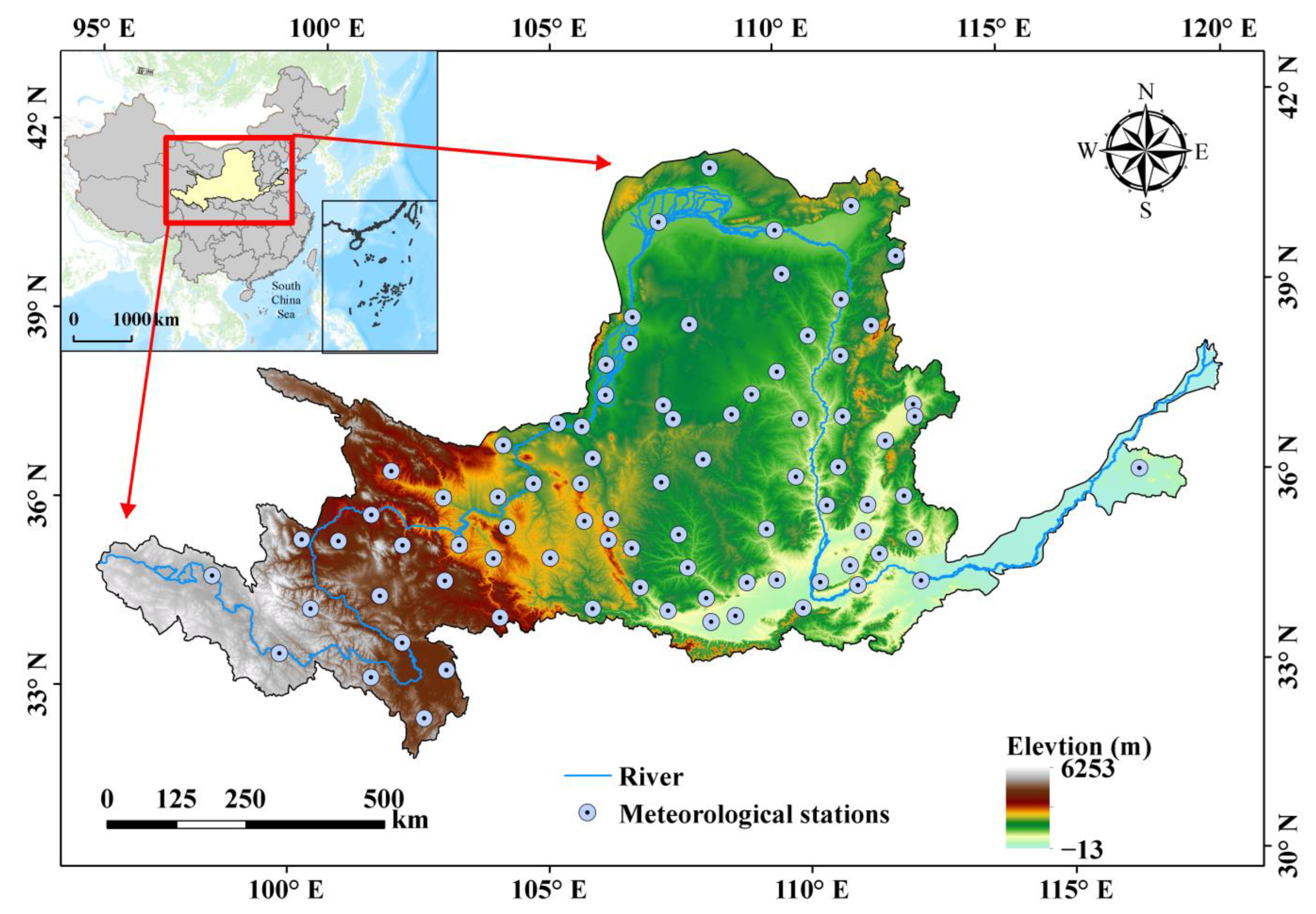
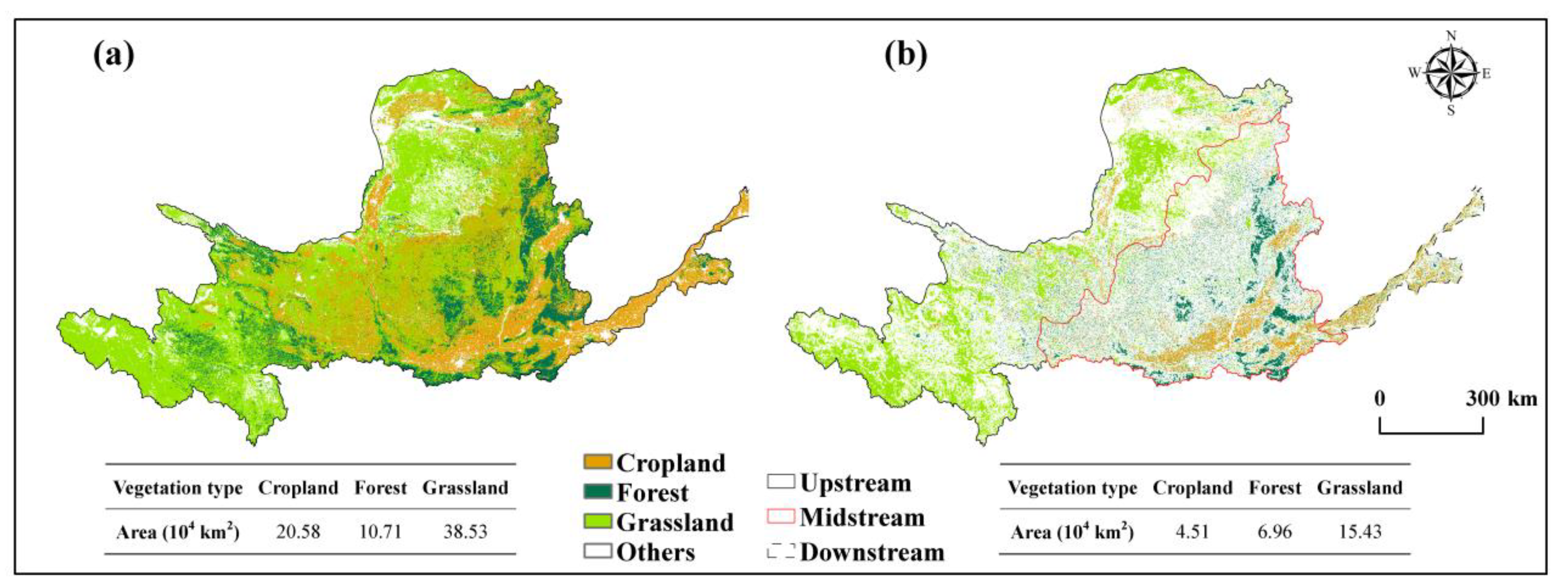
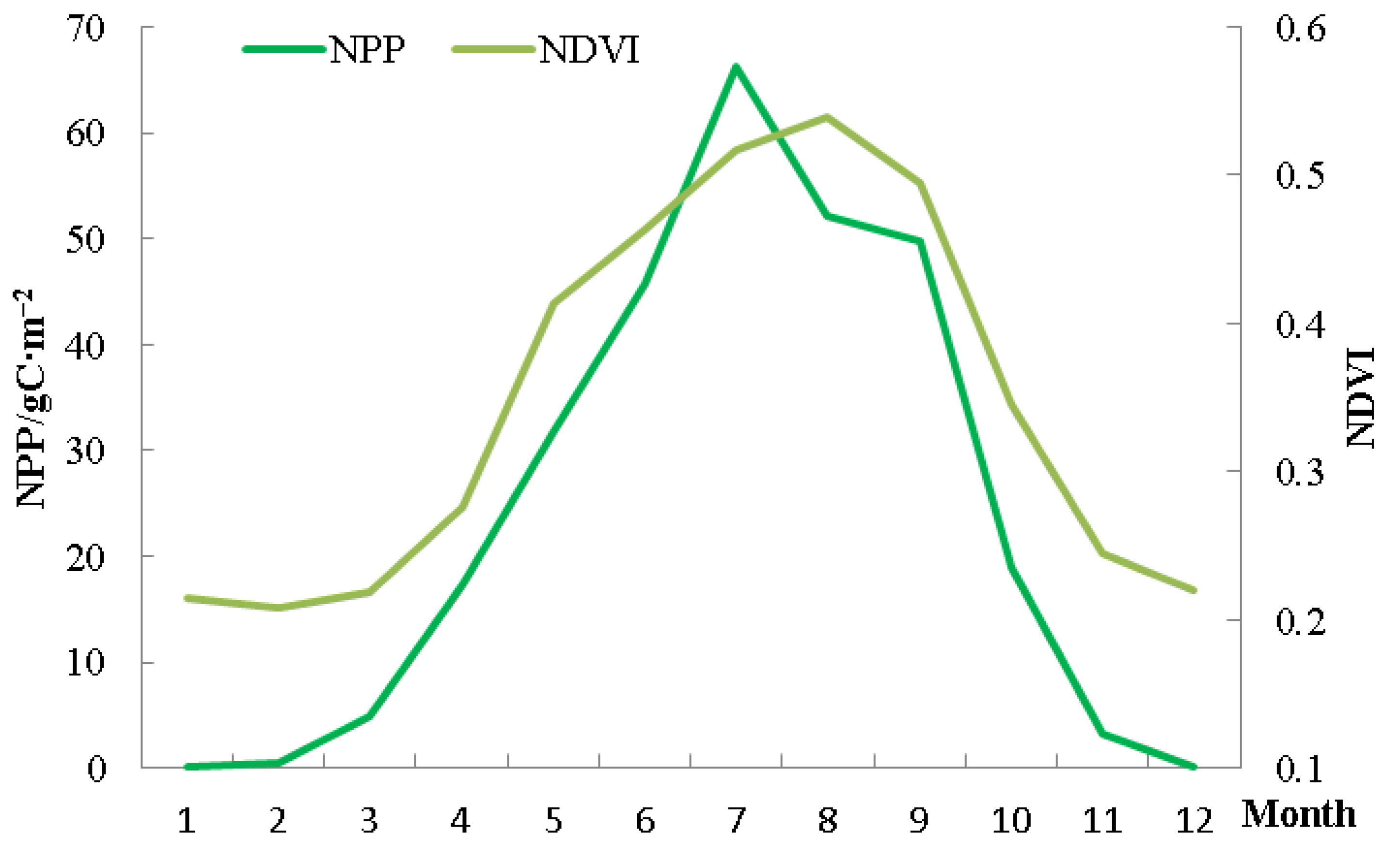


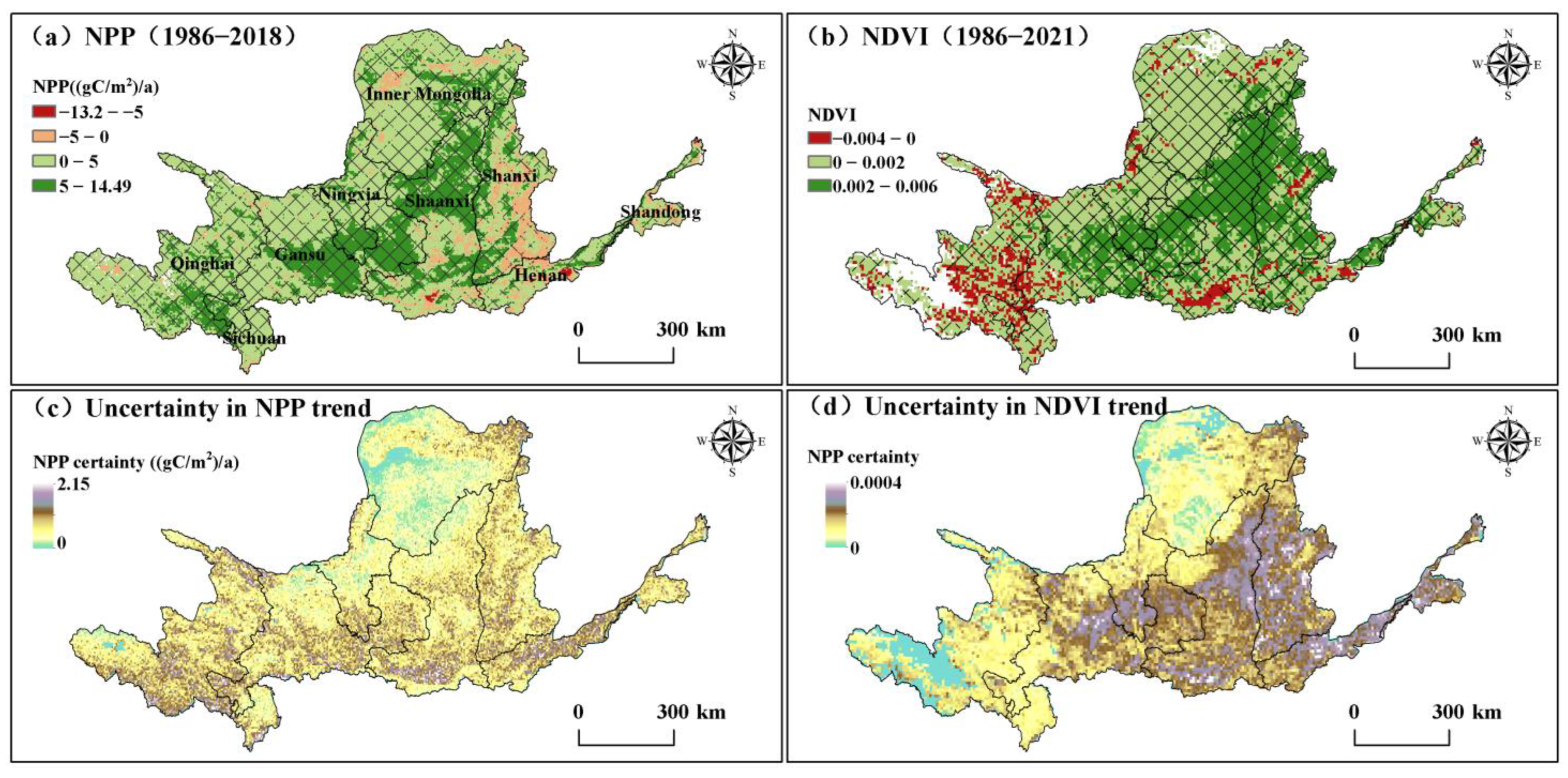

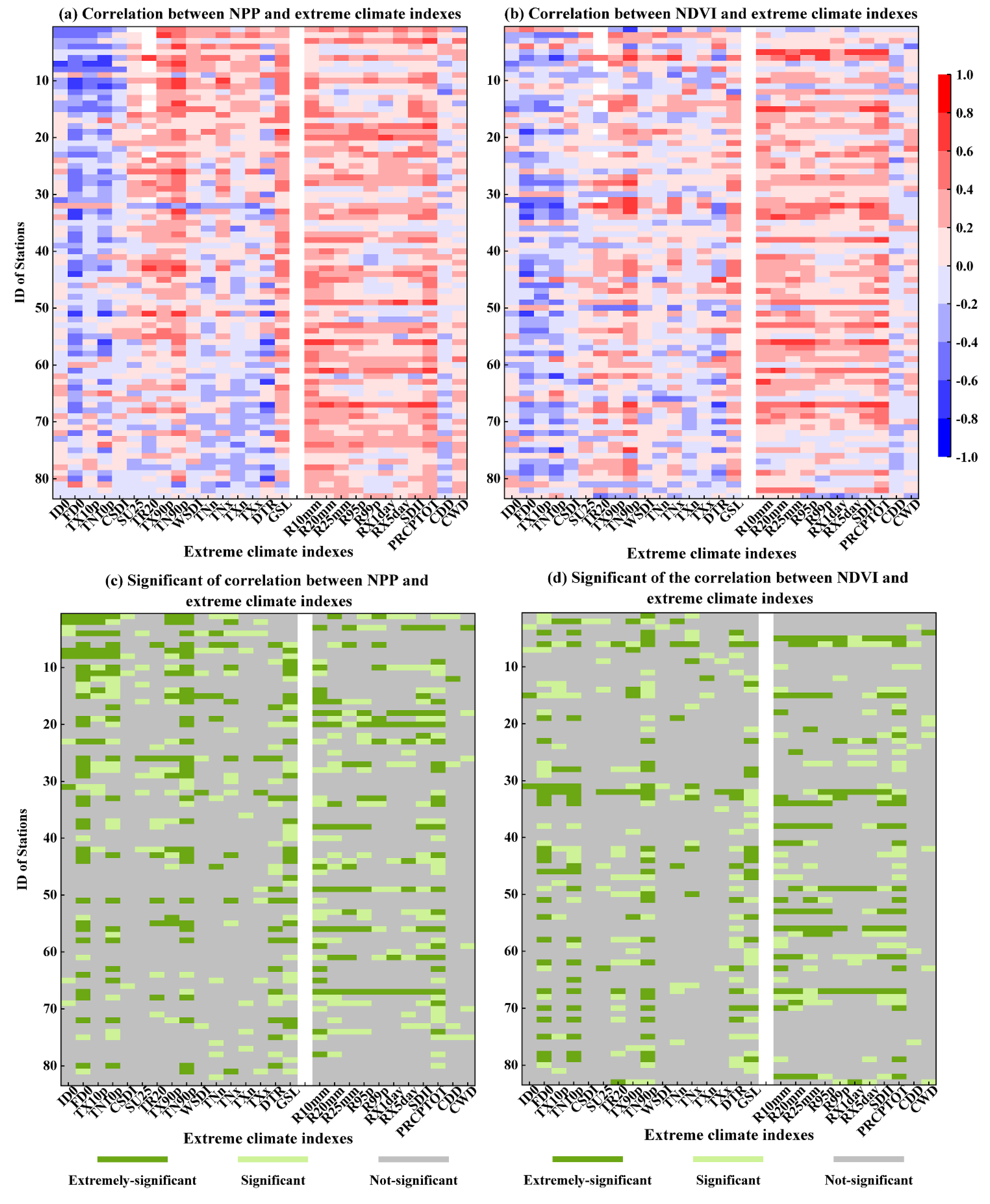

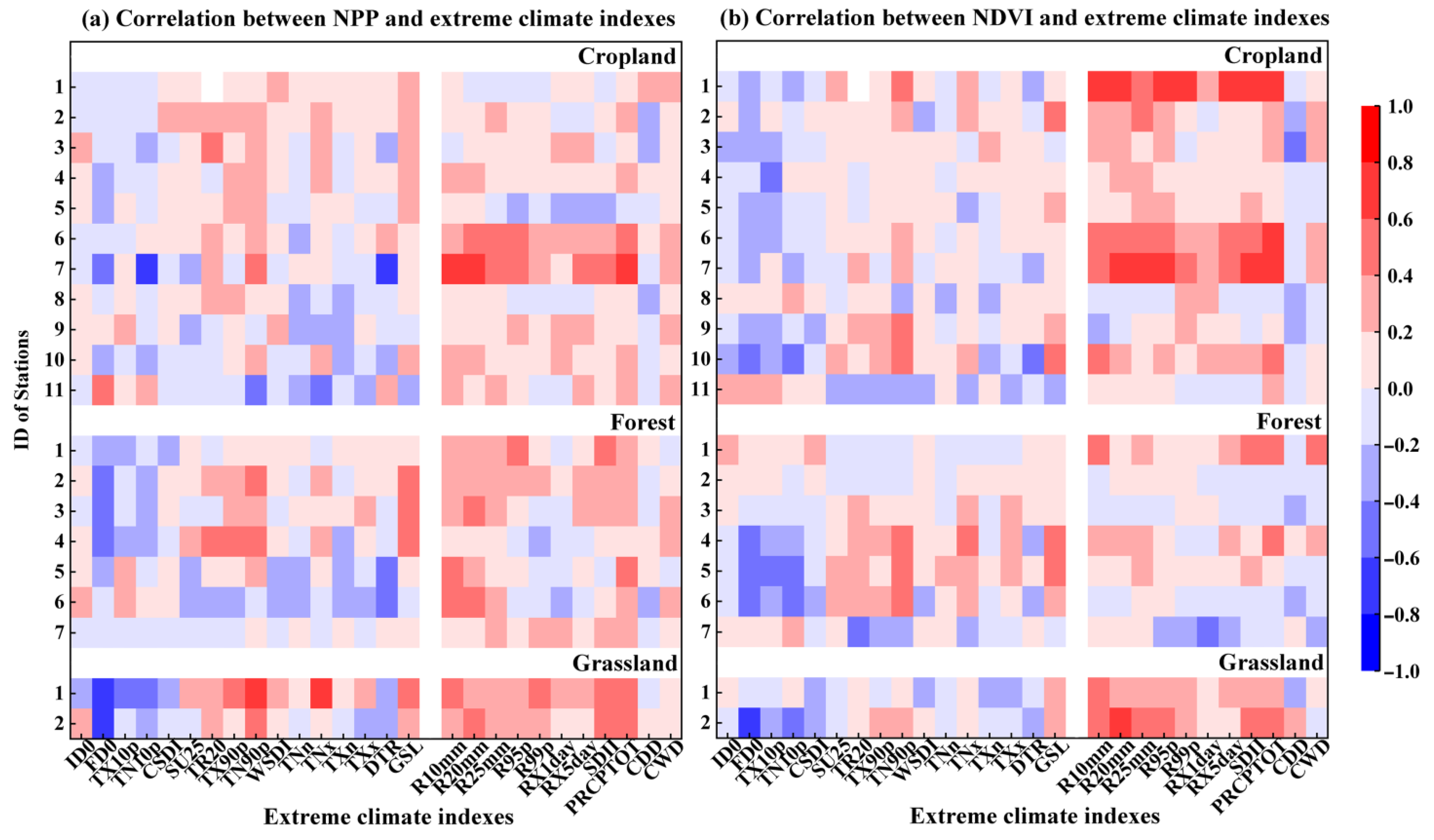
| Study | Vegetation Data Sources | Extreme Climate | Study Period | Location | Methods |
|---|---|---|---|---|---|
| Zhang et al. [21] | NDVI and solar-induced chlorophyll fluorescence (SIF) | Drought, extreme wet, extreme hot and cold | 2001–2018 | Tibetan Plateau | Event coincidence analysis and significant test |
| Mo et al. [22] | NDVI | 15 extreme temperature indexes and 10 extreme precipitation indexes | 1982–2015 | China | Partial correlation analysis |
| He et al. [23] | NDVI | Average precipitation, temperature and potential evapotranspiration; five extreme precipitation and temperature change | 1982–2015 | Global drylands | Linear regression method; partial correlation analysis; Pearson correlation analysis; geographical detector model |
| Wei et al. [24] | Leaf area index (LAI) | extreme hot and wet; extreme hot and dry; extreme cold and wet; extreme cold and dry climates | 1982–2016 | Middle–to–high latitudes in Asia | Standardized anomalies |
| Yan et al. [25] | NPP | 11 extreme temperature indexes and 4 extreme precipitation indexes | 1982–2019 | Yunnan plateau | Geographic detector |
| Index | Descriptive Name | Definition | Units | |
|---|---|---|---|---|
| Extreme temperature indexes | ID0 | Icing days | Annual count where daily maximum temperature < 0 °C | days |
| FD0 | Frost days | Annual count where daily minimum temperature < 0 °C | days | |
| TX10p | Cold days | Percentage of days when daily maximum temperature < 10th percentile | days | |
| TN10p | Cold nights | Percentage of days when daily minimum temperature < 10th percentile | days | |
| CSDI | Cold spell duration index | Annual count of days with at least 6 consecutive days when TN < 10th percentile | days | |
| SU25 | Summer days | Annual count where daily maximum temperature > 25 °C | days | |
| TR20 | Tropical nights | Annual count where daily minimum temperature > 20 °C | days | |
| TX90p | Warm days | Percentage of days when daily maximum temperature > 90th percentile | days | |
| TN90p | Warm nights | Percentage of days when daily minimum temperature > 90th percentile | days | |
| WSDI | Warm spell duration index | Annual count of days with at least 6 consecutive days when daily maximum temperature > 90th percentile | days | |
| TNn | Minimum TN | Monthly minimum value of daily minimum temperature | °C | |
| TNx | Maximum TN | Monthly maximum value of daily minimum temperature | °C | |
| TXn | Minimum TX | Monthly minimum value of daily maximum temperature | °C | |
| TXx | Maximum TX | Monthly maximum value of daily maximum temperature | °C | |
| DTR | Diurnal temperature range | Annual mean difference between daily maximum temperature and daily minimum temperature | °C | |
| GSL | Growing season length | Annual count between first span of at least 6 days with daily mean temperature >5 °C and first span after July 1 of 6 days with daily mean temperature <5 °C | days | |
| Extreme precipitation indexes | R10mm | Number of heavy precipitation days | Annual count of days when daily precipitation > 10 mm | days |
| R20mm | Number of heavy precipitation days | Annual count of days when daily precipitation > 20 mm | days | |
| R25mm | Number of heavy precipitation days | Annual count of days when daily precipitation > 25 mm | days | |
| R95p | Very wet days | Number of days with daily precipitation > 95th percentile | mm | |
| R99p | Extremely wet days | Number of days with daily precipitation > 99th percentile | mm | |
| RX1day | Max 1 day precipitation amount | Monthly maximum 1–day precipitation | mm | |
| RX5day | Max 5 day precipitation amount | Monthly maximum consecutive 5–day precipitation | mm | |
| SDII | Simple daily intensity index | Annual total ≥ 1mm precipitation divided by the number of wet days | mm/d | |
| PRCPTOT | Annual total wet day precipitation | Annual total precipitation in wet days | mm | |
| CDD | Consecutive dry days | Maximum number of consecutive days with daily precipitation < 1 mm | days | |
| CWD | Consecutive wet days | Maximum number of consecutive days with daily precipitation ≥ 1 mm | days |
| Extreme Climate Indexes | Index | Change Slope | Index | Change Slope |
|---|---|---|---|---|
| Extreme temperature indexes | ID0 | −0.12 | SU25 | 0.32 * |
| FD0 | −0.59 * | TR20 | 0.25 * | |
| TX10p | −0.25 * | TX90p | 0.38 * | |
| TN10p | −0.35* | TN90p | 0.63 * | |
| CSDI | −0.06 | WSDI | 0.10 | |
| TNn | 0.03 | TNx | 0.05 * | |
| TXn | −0.01 | TXx | 0.04 * | |
| DTR | −0.01 | GSL | 0.67 * | |
| Extreme precipitation indexes | R10mm | 0.09 * | RX1day | 0.16 * |
| R20mm | 0.05 * | RX5day | 0.45 * | |
| R25mm | 0.04 * | SDII | 0.03 * | |
| R95p | 1.33 * | PRCPTOT | 2.63 * | |
| R99p | 0.60 * | CDD | −0.20 | |
| CWD | 0.02 |
| NPP | NDVI | NPP | NDVI | |||
|---|---|---|---|---|---|---|
| Extreme temperature indexes | ID0 | −0.11 | −0.17 | TNn | −0.06 | 0.05 |
| FD0 | −0.74 ** | −0.64 ** | TNx | 0.52 ** | 0.41 * | |
| SU25 | 0.46 ** | 0.43 * | TXn | −0.20 | −0.10 | |
| TR20 | 0.58 ** | 0.55 ** | TXx | 0.22 | 0.19 | |
| TX10p | −0.38 * | −0.45 ** | DTR | −0.27 | −0.13 | |
| TN10p | −0.61 ** | −0.50 ** | CSDI | −0.18 | −0.20 | |
| TX90p | 0.48 ** | 0.45 ** | GSL | 0.75 ** | 0.63 ** | |
| TN90p | 0.76 ** | 0.65 ** | WSDI | 0.18 | 0.25 | |
| Extreme precipitation indexes | R10mm | 0.58 ** | 0.48 ** | RX1day | 0.36 * | 0.34 |
| R20mm | 0.61 ** | 0.53 ** | RX5day | 0.49 ** | 0.42 * | |
| R25mm | 0.57 ** | 0.49 ** | SDII | 0.45 ** | 0.46 ** | |
| R95p | 0.58 ** | 0.50 ** | PRCPTOT | 0.59 ** | 0.48 ** | |
| R99p | 0.46 ** | 0.36 * | CDD | −0.12 | −0.18 | |
| CWD | 0.29 | 0.22 |
Disclaimer/Publisher’s Note: The statements, opinions and data contained in all publications are solely those of the individual author(s) and contributor(s) and not of MDPI and/or the editor(s). MDPI and/or the editor(s) disclaim responsibility for any injury to people or property resulting from any ideas, methods, instructions or products referred to in the content. |
© 2023 by the authors. Licensee MDPI, Basel, Switzerland. This article is an open access article distributed under the terms and conditions of the Creative Commons Attribution (CC BY) license (https://creativecommons.org/licenses/by/4.0/).
Share and Cite
Cao, Y.; Xie, Z.; Huang, X.; Cui, M.; Wang, W.; Li, Q. Vegetation Dynamics and Its Trends Associated with Extreme Climate Events in the Yellow River Basin, China. Remote Sens. 2023, 15, 4683. https://doi.org/10.3390/rs15194683
Cao Y, Xie Z, Huang X, Cui M, Wang W, Li Q. Vegetation Dynamics and Its Trends Associated with Extreme Climate Events in the Yellow River Basin, China. Remote Sensing. 2023; 15(19):4683. https://doi.org/10.3390/rs15194683
Chicago/Turabian StyleCao, Yanping, Zunyi Xie, Xinhe Huang, Mengyang Cui, Wenbao Wang, and Qingqing Li. 2023. "Vegetation Dynamics and Its Trends Associated with Extreme Climate Events in the Yellow River Basin, China" Remote Sensing 15, no. 19: 4683. https://doi.org/10.3390/rs15194683
APA StyleCao, Y., Xie, Z., Huang, X., Cui, M., Wang, W., & Li, Q. (2023). Vegetation Dynamics and Its Trends Associated with Extreme Climate Events in the Yellow River Basin, China. Remote Sensing, 15(19), 4683. https://doi.org/10.3390/rs15194683








